
Jet Force Gemini is a 1999 third-person shooter developed and published by Rare for the Nintendo 64 video game console. The game follows the story of three members of a galactic law enforcement team as they try to stop a horde of drones led by an insectoid called Mizar. It features a single-player mode where the player must explore a galaxy and save Tribals, a race of survivors who have been enslaved and imprisoned by Mizar, and places strong emphasis on shooting large numbers of enemies while dodging their attacks. The game also includes a multiplayer mode where two to four players can compete in traditional deathmatch games.

Mega Man & Bass is an action-platform video game developed and published by Capcom. It is a spin-off game in the original Mega Man series and was originally released in Japan for the Super Famicom on April 24, 1998. It was later ported to the Game Boy Advance (GBA) handheld in 2002, and localized in English and released the following year.
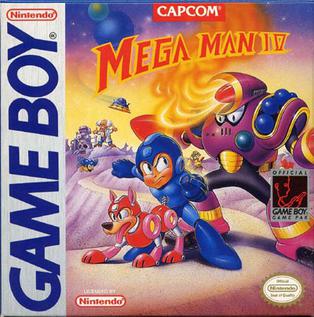
Mega Man IV is an action-platform video game by Capcom for the Nintendo Game Boy. It is the fourth installment in the handheld version of the Mega Man series. The game continues the quest of the protagonist Mega Man in the struggle with his long-time nemesis Dr. Wily, who sends out a disruptive radio signal to cause a rampage, citywide destruction from dormant robots. Mega Man IV features the traditional action platforming gameplay of the prior games while introducing one new feature, the ability to purchase items with power-ups found throughout each stage. As with previous Game Boy releases, the game incorporates gameplay elements and bosses from two sequential Nintendo Entertainment System (NES) games: Mega Man 4 and Mega Man 5. The game has received a warm critical reception. In 2013, Mega Man IV was made available on the Virtual Console of Japan's Nintendo eShop for the Nintendo 3DS. It was later released in the North American and PAL region eShops the following year.

Mega Man III is an action-platform video game by Capcom for the Nintendo Game Boy. It is the third game in the handheld version of the Mega Man series. The game follows the title character Mega Man as he fights the evil Dr. Wily, whose latest attempt to conquer the world involves sucking energy from the Earth's core to power a new machine. Along with foes from his past, Mega Man must contend with the next robot in Wily's line of "Mega Man Killers", Punk. Like its two consecutive predecessors on the Game Boy, the game combines elements from two previously released Nintendo Entertainment System (NES) titles: Mega Man 3 and Mega Man 4. In 2013, Mega Man III was made available on the Virtual Console of Japan's Nintendo eShop for the Nintendo 3DS. It was later released in the North American and PAL region eShops the following year.

Kirby 64: The Crystal Shards is a 2000 platform game developed by HAL Laboratory and published by Nintendo for the Nintendo 64 (N64). It is the first Kirby game to feature 3D computer graphics and follows Kirby as he attempts to reassemble a sacred crystal shattered by Dark Matter. Gameplay is viewed from a 2.5D perspective and is similar to previous Kirby titles; the player traverses levels and obtains powers by eating enemies. Kirby 64 introduces Power Combos, the ability to mix powers to create more powerful ones. In a multiplayer mode, up to four players can compete in three minigames.

Tonic Trouble is a 1999 action-adventure game developed by Ubi Soft Montreal and published by Ubi Soft. The game follows janitor Ed, who drops a container of unidentified fluid from his spaceship to Earth, transforming the planet into a mutated version of itself. Drunkard Grögh drinks from the container and is granted powers that lead him to conquer Earth. Assuming the role of Ed, the player is tasked with solving puzzles and defeating enemies to acquire the tools to conquer Grögh and repossess the container to create an antidote.

Mega Man Xtreme is a 2000 video game developed by Capcom for the Game Boy Color handheld console. It is a spin-off title in the Mega Man X series of video games that originated on the Super Nintendo Entertainment System. Mega Man Xtreme takes place within the series timeline during the 22nd century, in which a group of "Maverick" androids called the "Shadow Hunters" hack into the world's "Mother Computer" system, destabilize all of the networks, and allow other Mavericks to cause rampant destruction all over the world. The heroic "Maverick Hunter" X is tasked with going into cyberspace to relive his past missions and put a stop to the group's plans.
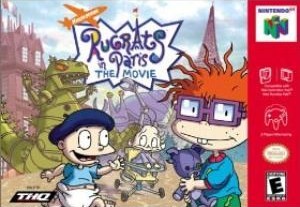
Rugrats in Paris: The Movie is a video game based on the 2000 animated movie of the same name. The game follows the adventures of the Rugrats in a European theme park. A console version of the game was released in 2000, for the PlayStation, Nintendo 64, and a handheld version for Game Boy Color. A version for Microsoft Windows was later released in 2001. The console version's gameplay is similar to Rugrats: Studio Tour, but Paris’ attractions sometimes have minigames too. The handheld gameplay is a side-scrolling platformer. The Windows version's gameplay is an adventure game in which the player must find Chuckie's Wawa Bear.

Batman Beyond: Return of the Joker, known as Batman of the Future: Return of the Joker in Europe, is a scrolling beat 'em up video game developed by Kemco and released by Ubi Soft for the Game Boy Color, PlayStation and Nintendo 64 in 2000 and 2001. The game is based on the film of the same name, which in turn was based on the TV series Batman Beyond. Players act as the new Batman Terry McGinnis, who takes over the position of the retired Bruce Wayne and fights against the Jokerz gang led by the recently revived Joker. Throughout the game, Batman fights the villain's cronies, who steal tech components from various laboratories and corporations in Gotham City. Joker uses them to take control of a missile-shooting satellite, which he plans to destroy the entire city with.
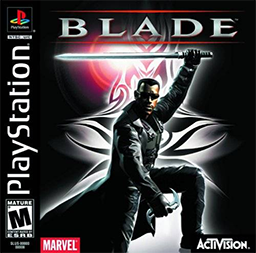
Blade is an action game based on the 1998 film Blade. It was developed by HammerHead for the PlayStation in 2000, and by HAL Laboratory and Avit Inc. for the Game Boy Color. The game was published by Activision and serves as a prequel to the movie, following the adventure of Blade with help of his mentor and friend Abraham Whistler. Reviews were mixed, with criticism of the graphics, camera, controls, and voice acting.
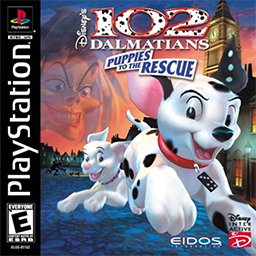
Disney's 102 Dalmatians: Puppies to the Rescue is a 2000 platform game developed by Toys for Bob and published by Eidos Interactive for Microsoft Windows, PlayStation, Dreamcast and Game Boy Color. It is loosely based on the live-action Disney movie 102 Dalmatians.
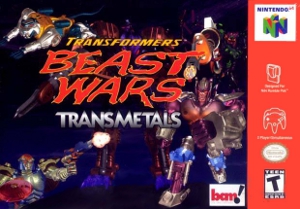
Transformers: Beast Wars Transmetals is a 1999 3D fighting game based on the Transformers: Beast Wars cartoon series and toy-line for the Nintendo 64 and PlayStation. Each version features different mechanics and playable characters.

40 Winks is a platform video game developed by Eurocom Entertainment Software and published by GT Interactive for the PlayStation. A version was developed for the Nintendo 64, and reviewed in both Nintendo Official Magazine UK and Nintendo Power, but was cancelled before release.

Elevator Action EX is an update to the Game Boy version of Elevator Action published by Altron in 2000. In addition to colour, players can choose between three characters: Mike, an all rounded character, Guy, a slower yet more durable character, and Sarah, a faster yet weaker character.
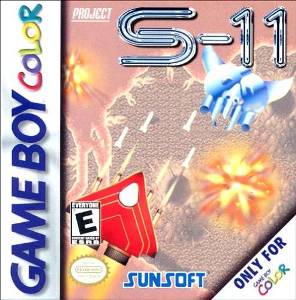
Project S-11 is a game developed by Paragon 5 and published by Sunsoft for the Game Boy Color. It was released in North America on January 3, 2001.
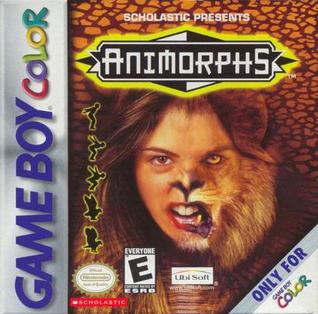
Animorphs is a 2000 game for Game Boy Color. It is based upon the Scholastic book series Animorphs by K. A. Applegate.

Mega Man 7 is an action platform video game developed and published by Capcom for the Super Nintendo Entertainment System. It is the seventh game in the original Mega Man series. The game was released in Japan on March 24, 1995 and was localized later in the year in North America and Europe.

Tarzan is a 1999 platform game based on the 1999 film of the same name. Versions were released in North America for the Game Boy Color on June 28, 1999, PlayStation and Microsoft Windows on June 30, 1999, and Nintendo 64 in February 15, 2000. In 2012, the PlayStation version was made available on the PlayStation Store for PlayStation Vita.

Buzz Lightyear of Star Command is a platform/shooter video game developed by Traveller's Tales and published by Disney Interactive and Activision in 2000. It is based on the animated series of the same name, a spin-off of the Toy Story franchise. It was released for Dreamcast, PlayStation, Microsoft Windows, and Game Boy Color. A version for the Nintendo 64 was planned but was later cancelled for unknown reasons.

The World Is Not Enough is a first-person shooter video game developed by Black Ops Entertainment and based on the 1999 James Bond film of the same name. It was published by Electronic Arts and released for the PlayStation on November 7, 2000, shortly after the release of its Nintendo 64 counterpart. The World Is Not Enough is the successor to Black Ops Entertainment's 1999 title Tomorrow Never Dies and uses an improved version of its engine. The game received mixed reviews from critics, who criticised its short length and lack of multiplayer mode.






















